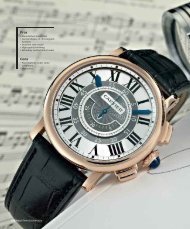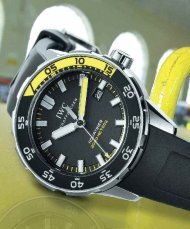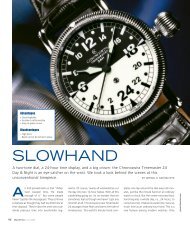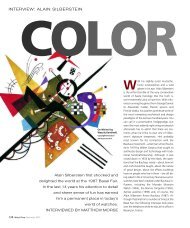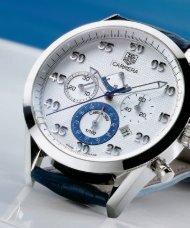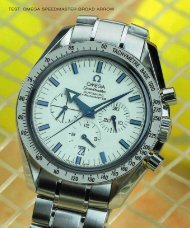WT_2004_05: ROLEX: THE STATUS SYMBOL
WT_2004_05: ROLEX: THE STATUS SYMBOL
WT_2004_05: ROLEX: THE STATUS SYMBOL
Create successful ePaper yourself
Turn your PDF publications into a flip-book with our unique Google optimized e-Paper software.
<strong>ROLEX</strong><br />
PR for the first water-resistant wristwatch:<br />
swimmer Mercedes Gleitz…<br />
in the right direction had been the use of<br />
screw-in cases made by Dennison Watch<br />
Case. These cases are readily identifiable by<br />
the fluting on the rims of their crystals and<br />
backs. This channeling makes both components<br />
easy to grasp so that they can be<br />
screwed to the middle part of the case. This<br />
60 WatchTime October <strong>2004</strong><br />
…swam across the English Channel with an<br />
Oyster on her wrist.<br />
visible attribute continues to distinguish the<br />
backs of Rolex watches today.<br />
Wilsdorf relied on a purely mechanical construction<br />
without problematic materials. His formula<br />
for success can be summarized as follows:<br />
1. a hermetically sealed case, each part of<br />
which is screwed water-resistant;<br />
An early advertisement<br />
for the Rolex Oyster.<br />
The first<br />
Rolex Oyster<br />
from 1926.<br />
2. a new and perfectly form-fitting crystal<br />
made of synthetic material; and<br />
3. a crown that lastingly protects the movement<br />
against moisture penetration, even if the<br />
crown is operated daily.<br />
Wilsdorf purchased the rights to use an<br />
idea that had originally occurred to Georges<br />
Peret and Paul Perregaux. In October 1925,<br />
these two men became the first watchmakers<br />
to screw a crown onto a watch’s case. Rolex<br />
applied for a patent on a threaded case on<br />
September 21, 1926. Another application followed<br />
on October 18, this time for patent protection<br />
on a crown that was screwed to the<br />
middle part of the case. Corresponding<br />
patents were soon granted in Switzerland and<br />
Great Britain. There wasn’t much need for research<br />
because Rolex’s revolutionary inventions<br />
were entirely unprecedented. All that<br />
was missing was a catchy name to aptly express<br />
the characteristic attribute of the new<br />
case. After considering several possibilities, the<br />
name was chosen: “Oyster.”<br />
The first official appearance by the Oyster<br />
came soon thereafter. Mercedes Gleitze, a<br />
young stenographer from London, swam<br />
across the English Channel in the record-breaking<br />
time of just 15 hours and 15 minutes on October<br />
7, 1927. Afterwards, she showed her<br />
perfectly functioning Rolex to a crowd of astonished<br />
reporters. To publicize this sensational<br />
achievement, Wilsdorf ran a full-page ad on<br />
the front page of the Daily Mail. Although the<br />
ad cost Rolex a king’s ransom, more than 2 million<br />
readers saw the ad when the newspaper<br />
was published on November 24, 1927.<br />
Wilsdorf supplied his dealers with small,<br />
patented aquariums to display in their shop<br />
An Oyster model<br />
from 1928.



